written and copyrighted by Týra Alrune Sahsnotasvriunt
This is the second part of the Germanic Women series. In the first part the role of the Sibyllen/Völvas, Matrons, Norns and Disir were covered.
Walküren (Valkyries)
The Walküren once were more than just „Wotan’s Wishmaidens“. The independent guardian spirits of the dead suddenly had a stern, “all-powerful” master in Wotan, and were not good for much else than to fulfill his personal demands and act on his whims.
The origins of the Walküren lie in the pre indo-Germanic mother/Goddess cult. Their name alone sparks terror, for Old Norse valkyrjar and Old English waelcyrge mean those who choose the corpses (from the battlefield) or literally “corpse-chooser”.
The only account regarding the original independent nature of the Walküren is found in the Njalssaga. It speaks of twelve females sitting at a weaving chair inside a mound. Their weaving wool is made of human intestines, the weights for looms are made up of male skulls. They are singing a song about harvesting the warriors on a battlefield.
After finishing their grisly incantation the Walküren leave the mound, six of them ride towards the South and six towards the North. (Six to Muspilli and six to Nifl? Also, six is the number of rebirth or renewal by destruction; this is the Kenaz rune principle, the sixth rune of the Futhark dedicated to world-renewer Loki.)
It is insinuated that while they are sitting inside the mound weaving the warriors’ fates they are at the same time present on the battlefield itself.
Like the Nornen the Walküren alone decide what to weave, what warriors, both male and female, to choose and who to spare.
Neither prayer nor offering will change their decision; they are independent and do not answer to any God such as Wotan, let alone humans.
As already mentioned their independence was taken from them later on; but even worse, in Medieval Skaldic Poetry the Walküren are described as lowering themselves enough to fall in love with mortals.
These beings obviously have nothing in common with the strong, independent female guardian spirits that once wove the fates of warriors; instead they let humans determine theirs (!) as the story of Brünhilde and Siegfried (Das Nibelungenlied) shows.
This particular storyline of the Nibelungs is especially interesting as it points to the death of the Mother Goddess cult, which did not suit the rigid and patriarchal structures of Medieval, and most importantly increasingly Christian, society.
In the course of the story Brünhilde the Walküre is betrayed and dethroned by men. Still, as long as she is in possession of her magical belt, she remains independent to a degree.
Siegfried and Gunther trick her, forcing off her belt and Siegfried rapes her in front of her husband, Gunther. The matriarch is dead, figuratively speaking, and as she falls and the balance between male and female rule is destroyed, thus falls all of mankind: The saga of the Nibelungs ends with an inferno no one survives, a kind of Ragnarök on a smaller scale.
The same principle can be found in Véølundarkvipa. Here, as much as in several folk tales, the Walküren are depicted as swans. The swan, representing purity both spiritually as well as physically, was also associated with the soul and death in general.
In Véølundarkvipa the swan girls fly through the dark forest to “ørlog drýgja” – decide (clan/family) fate. They sit down at a lake, taking off their wings and feathers to “weave fine linen”, in other words they weave the fate(s) of the warriors on the battlefield.
Wölund and his brothers steal their feathers and force them to take them as husbands. 7 years go by in which the Walküren yearn to return to weaving the fates of the warriors. In the 8th year they plot their escape, in the 9th year (note the sacred number 9 in this context) they leave behind their captors and children to become what they once were. This, of course, is a bit of a happier ending, if only slightly.
There is also an Anglo-Saxon blessing in which the Walküren are basically described as a witch army riding in the sky and casting their spears down into the warriors’s backs, claiming them thus. The (German) Saxons held a similar view of the Walküren and so even in today’s German we use the word Hexenschuß (“witch shot”) for lumbalgia.
It is the Idisen (Disir) that are specifically named in the first Merseburg Incantation, yet it is impossible not to think of the Walküren when reading the following:
“Eiris sazun idisi, sazun hera duoder,
suma hapt heptidun, suma heri leridun,
suma clubodun umbi cuoniouuidi:
insprinc haptbandun, inuar uigandun”
Once Disir were sitting, sitting here and there.
Some were binding fetters, some were restraining the army.
Some were undoing the fetters, ????????
Free yourself from the fetters, escape the warriors!
Are the Walküren Hlokk (“restraint/chain”) and Herfjotr (“fetter”) described in this charm? It becomes clear that the idea of Idisen, Walküren, Nornen, Alrunen (witches), anthropomorphic Fylgjen, Hamingjen and others all seem to have influenced each other to some degree; it can be tricky to distinguish between them nowadays because contemporary Norse and Germanic Pagans mostly don’t make the same tribal distinctions between Gods, beings and practices anymore as was common in the old days. To shed some light on the Idisen/Walküren mystery though: In Germany the Norse Valkyries were adopted from the Norse and the Idisen turned into meek, benevolent female spirits, often ancestral spirits.
Alrune, Heid, Haegse – The Witches
There is a common misconception amongst the majority of today’s witches that everything was peachy for witches in “ye olden days”. This is not completely the case with the Germanic peoples.
There were Healers and Herbalists, those we would call Naturopaths today. They applied their potions, crèmes and herbs while whispering charms or prayers.
Healing used to be a solely female occupation and was passed on from mother, aunt or grandmother to the younger female generation of one family; there are no accounts of male healers from those times at all. Under certain circumstances women could fight alongside the men on the battlefields, yet men were barred from entering the areas of “female mysteries” without exception.
Countless accounts from Viking times mention that the Germanic healers that accompanied their army or troop set up their tents near the battlefield and treated both their own men as well as the hostile warriors.
They treated them no differently and if need arose, they buried them and spoke a blessing over their grave as well.
One example is the account of the healer Halldora:
“Halldora called her women to follow her into the battle between Glums against Thorarinn. – “We shall tend to the wounds of the men who are still filled with life, no matter which army they are from”.
The story mentions another interesting belief from those days; healers could not only heal but resurrect the dead as Helga did with Thorarinn.
What might the mighty Walküren have thought of this? Or did this happen in accordance with them?
Another thought comes to mind. – What of Iduna and her “magical” (healing) apples? Once the Asen Gods did not have them at their disposal they grew old and withered. Had Iduna not returned in time to rejuvenate them and they had died, would she have been able to resurrect them as well?
It is Eir that is the healer amongst the Asen, but not even she holds the power to resurrect the dead. This truly is a practice that reeks of witchcraft rather than (natural) healing.
Many unanswered questions remain when it comes to “loopholes” in the usually very structured Germanic belief system of old.
The Völven (aka Sibyllen, Spákonur, Wicce – Wise Women/Seers), already mentioned in part 1, often traveled from Hof (farm) to Hof, offering their services and in return demanding food and shelter until they journeyed on.
Whether these women, who were often called to mediate between two opposing tribes or political factions within one tribe, possessed actual magical powers or were mainly mentalists with exceptional power of observations is a matter of interpretation I presume.
They did, however, consult the runes (as described in the accounts of the battle between Sueban king Ariovist against Cesar 58 BC for example) and worked with other oracles and incantations called vardlokkur (spirit-luring) in Old Norse.
The lines were blurred between Völven and Wîsiu Wîp, wise women, as they were called in German and Spákonur (seeing women) in Old Norse.
 Divination was regarded as a high magical art indeed, yet witchcraft was also often viewed as harmful and dangerous as it was a direct infringement onto the personal wyrd and orlog of a person. The further the North was christianized the more Christianity influenced the beliefs of those who remained Pagan.
Divination was regarded as a high magical art indeed, yet witchcraft was also often viewed as harmful and dangerous as it was a direct infringement onto the personal wyrd and orlog of a person. The further the North was christianized the more Christianity influenced the beliefs of those who remained Pagan.
Had they already been skeptical and partly fearful of certain types of witchcraft, they now fell prey to the mass-hysteria and bottomless fear of witches; they persecuted and banished those accused of practicing magic almost as much as the Christians did.
There were many different names for witches, specifying what kind of witchcraft they practiced. The more Christianity wreaked havoc the more negative connotations these originally rather neutral names received.
The word Haegse originally meant fence-seer in Old High German. It was related to the Old High German word Hagazussa meaning fence-sitter and the Old Norse word Túnridur meaning fence-rider.
Both are pointing to the Shamanic practice of traveling between the worlds.
Later, however, the Haegsen and Hagazussen were suddenly described as being monstrous, evil magic-weavers living in the deep, dark forest and coming out at night to plague and harm common people.
The word fence-sitter or fence-rider was reinterpreted as meaning that the witches were breaking the “Hoffrieden” (literally: farm-peace) and destroying the sacred barriers (fences) of the community against unlucky and negative forces.
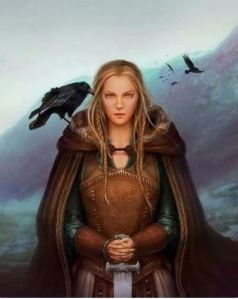 Likewise the terms Myrkridur (Old Norse: Darkrider), Kveldridur (Old Norse: Eveningriders), or Nahtvrouwen (Old High German: Nightwomen) were also reinterpreted to mean something solely negative and sinister, instead of describing the practice of diving into the “dark”, i.e. subconscious powers within via Shamanic or other magical journeys.
Likewise the terms Myrkridur (Old Norse: Darkrider), Kveldridur (Old Norse: Eveningriders), or Nahtvrouwen (Old High German: Nightwomen) were also reinterpreted to mean something solely negative and sinister, instead of describing the practice of diving into the “dark”, i.e. subconscious powers within via Shamanic or other magical journeys.
The Hamhleypa (Icelandic: Running into a different Shape = shapeshifter) were accused of transforming into an animal and bringing on hail, storms, being responsible for a bad harvest, the death of cattle or children. These misconceptions about witches lived far beyond the middle ages and frighteningly are embraced by a majority of the followers of the monotheistic religions to this day.
 There is one famous incantation in the Hávamál (13th century) against the “evil witchcraft” of the Hamhleypa:
There is one famous incantation in the Hávamál (13th century) against the “evil witchcraft” of the Hamhleypa:
“One tenth I know, when Trollkonor (Magical Women)
Ride through the air in flight:
Make them change their route I can[.]
Homeward, robbed of their cover (their animal form or (dis)guise)
Homeward with a confused mind.”
The author of the Hávamál, the Icelander Snorri Sturlason, was a Christian who lived in a completely Christian society already, so his accounts of witches (and alleged incantations warding them off) better be taken with a grain of salt.
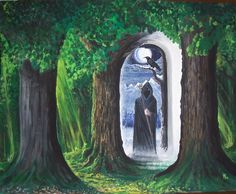 Similar to the Hamhleypa was the practice of Hamfór and Gandreiðr. As mentioned in part 1, a Gand or Gander was a kind of wand, but Gandr also meant spirit, ghost, other-worldly creature. A Gandreiðr was “spirit-riding”, basically a magical, Shamanic journey during which you could see your past, present or future in a different light. Likewise the Hamfór was a spiritual journey during which your soul left the body and traveled through different spheres to gather information.
Similar to the Hamhleypa was the practice of Hamfór and Gandreiðr. As mentioned in part 1, a Gand or Gander was a kind of wand, but Gandr also meant spirit, ghost, other-worldly creature. A Gandreiðr was “spirit-riding”, basically a magical, Shamanic journey during which you could see your past, present or future in a different light. Likewise the Hamfór was a spiritual journey during which your soul left the body and traveled through different spheres to gather information.
The giantess Hyrrokin was described as riding on a wolf (gezäumt) with snakes when attending Balder’s funeral. Hyrrokin is sometimes equated with Angerboda. Did Angerboda-Hyrrokin attend Balder’s funeral during her Gandreid in order to see or secure his future after Ragnarök? If not by her consort Loki’s doing, Balder would not have been kept safe by Hel during the end battle so he could return to the New World afterwards.
 Other names for witches were Alrunen (all-whisperers/rune-expert), Heid (clear, bright), Fordoeða (Murderer), Wicce (pronounced “witcheh”. Anglo-Saxon: knowledgable, wise, from which the modern term “Wicca” comes from), Anglo-Saxon Witega (knowing signs), Old High German Wizago (German: “Weissager”) and Old Norse Vitki all describe someone who is knowledgeable in the art of divination (usually conducted with runes).
Other names for witches were Alrunen (all-whisperers/rune-expert), Heid (clear, bright), Fordoeða (Murderer), Wicce (pronounced “witcheh”. Anglo-Saxon: knowledgable, wise, from which the modern term “Wicca” comes from), Anglo-Saxon Witega (knowing signs), Old High German Wizago (German: “Weissager”) and Old Norse Vitki all describe someone who is knowledgeable in the art of divination (usually conducted with runes).
The Old Norse word Galster is related to Old High German Kalstahari, a term for someone who knows how to sing the magical songs, the vardulokkur or galdralát as described above.
Although there are some historians and scholars who insist that all witchcraft was persecuted pre-Christian times, the different descriptions and attributes of the different terms for ‘witch’ indicate otherwise.
After all several Gods (Freija, Holle-Frigga, Iduna, etc.), Jöten and Thursen (Hyrrokin, Heid, Gullveig, Elli, Fenja and Menja, etc.) and wights practice magic and/or witchcraft without any negative connotation in lore. The Völva of the Völuspa, Heidi, is human even and both humanity as well as Gods were grateful for her messages.
The Edda teaches that Wotan even crossed the social taboo of forcing himself into the sacred space of female mysteries such as healing, witchcraft and divination; he learned the “womanly” art of Seid, the art of divining with the help of the spirits (of the deceased), something that Völven traveling from Hof to Hof also often engaged in.
However, Seid (Old Norse: Seidhr) became popular enough for several males to become Seidmen. These men were often looked down upon, probably because this “womanly” practice was of female Wanen origin and it was mentioned that the war-happy Asen were helpless against the Seid magic of the Wanen deities.
 Seid could also be used against people as described in the stories of the witch Busla who curses a king with galdr to do her bidding and in Laxdoelasaga it is the farmer Thorleikr who asks the witch Grima to help him curse his neighbor.
Seid could also be used against people as described in the stories of the witch Busla who curses a king with galdr to do her bidding and in Laxdoelasaga it is the farmer Thorleikr who asks the witch Grima to help him curse his neighbor.
In both cases the witches cursed the men while they were asleep and helpless, something that influenced the medieval (Christianized) belief of “demonic” Alben riding people’s chests at night in order to cause bad dreams and bad luck.
Since the Germanic peoples were all highly virtuous and incredibly brave folks with a strong morale of right and wrong it comes as no surprise that such cowardly practices that avoided a fair and open fight were condemned and despised.
In fact, they were even punishable by fine or in the case of Ragnvold in the Förnmannasaga it was even punishable by death.
It’s also possible that Seid, “death magic”, was also feared more than other forms of divination, because of the old Germanic belief in aptrgangr, draugr, other kinds of revenants and ghostly beings out to harm humans.
Seid is often described as being accompanied by heavy storms, the Gerningaveðr (magical weather).
In later times people were of the opinion that only evil magic brought on such storms.
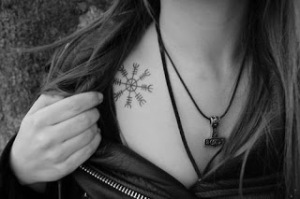 Yet…where was Thor when his domain was invaded like this? Is this just an indication that the Gods did not intervene unasked, much like nowadays when we pollute and destroy the earth given to us, or that while humans viewed such witchcraft and storms as evil the Gods did not? Who knows.
Yet…where was Thor when his domain was invaded like this? Is this just an indication that the Gods did not intervene unasked, much like nowadays when we pollute and destroy the earth given to us, or that while humans viewed such witchcraft and storms as evil the Gods did not? Who knows.
Fact is that even in today’s Germany we know the term Wetterhexe (weather witch) which is used either to describe meteorologists but also people very sensitive to the weather, and is not associated with anything harmful or negative (anymore).
 Female Warriors
Female Warriors
There were active and passive female warriors. The passive warriors accompanied their tribe’s army or troop and cheered them on from the sidelines of the battlefield.
Plutarch writes that during one particular battle the Teutonic warriors tried to retreat. Their women ran at them with axes and swords, fighting them – the traitors – as much as their enemies, the Romans. This appears to be a common phenomenon amongst the Germanic tribes as Tacitus in his “Germania” and Cesar in his “De Bello Gallico” confirm.
Furthermore, Tacitus writes that the women used psychological warfare against their own men by shouting at them to spare them and the children the humiliation of Roman captivity and all the gruesomeness it entailed.
If their men fought successfully the Germanic women would bear their breasts and shake them so as to keep up the motivation of the warriors.
Active female warriors (“shieldmaidens”) often bore names ending with or including the syllables wig, hild, gund, gart, hadu, ger (spear), brünne, helm (helm) etc. They were found in all known Germanic and Scandinavian tribes. Were they raised to become warriors or did they choose their (warrior) names later on as they decided to join the army?
Even in the saga of Erik the Red we hear of brave Freydis, the pregnant wife of a warrior, who actively joins the battle, fighting with exposed breasts. Something that confused and frightens the enemies so much that they escape as quickly as possible.
Two factors influenced the drastic change in Pagan Germanic societal structure in which women had had a relatively good standing: The diffusion of the Wotan cult and the increasing contact with the Christian Romans who did not grant any rights to women.
Before the Winniles had accepted the Wotan cult and renamed themselves Langobards their women had had the right to carry swords, axes and other weaponry and use it as well. If not for them, they would not have defeated the Vandals.
However, in 568, after they had settled in Northern Italy, they enacted laws that clearly stated that women were absolutely forbidden to carry or use weapons.
Either due to societal change or by (Christian) law and conversion, one after another all Germanic tribes began treating their women as second-class citizens without any rights, feelings nor wits. The beginning of the dark age.
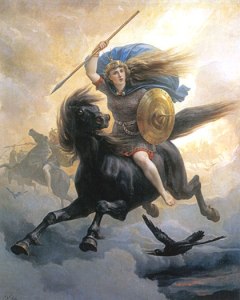



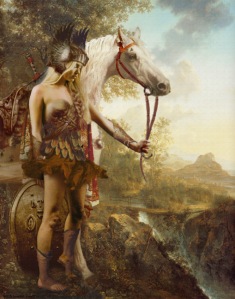








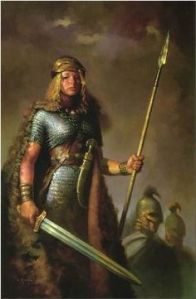

Feb 25, 2015 @ 19:50:33
Really enjoyed the article. Definitely, food for thought! Thank you
LikeLike
Feb 25, 2015 @ 20:26:02
Thank you!
LikeLike